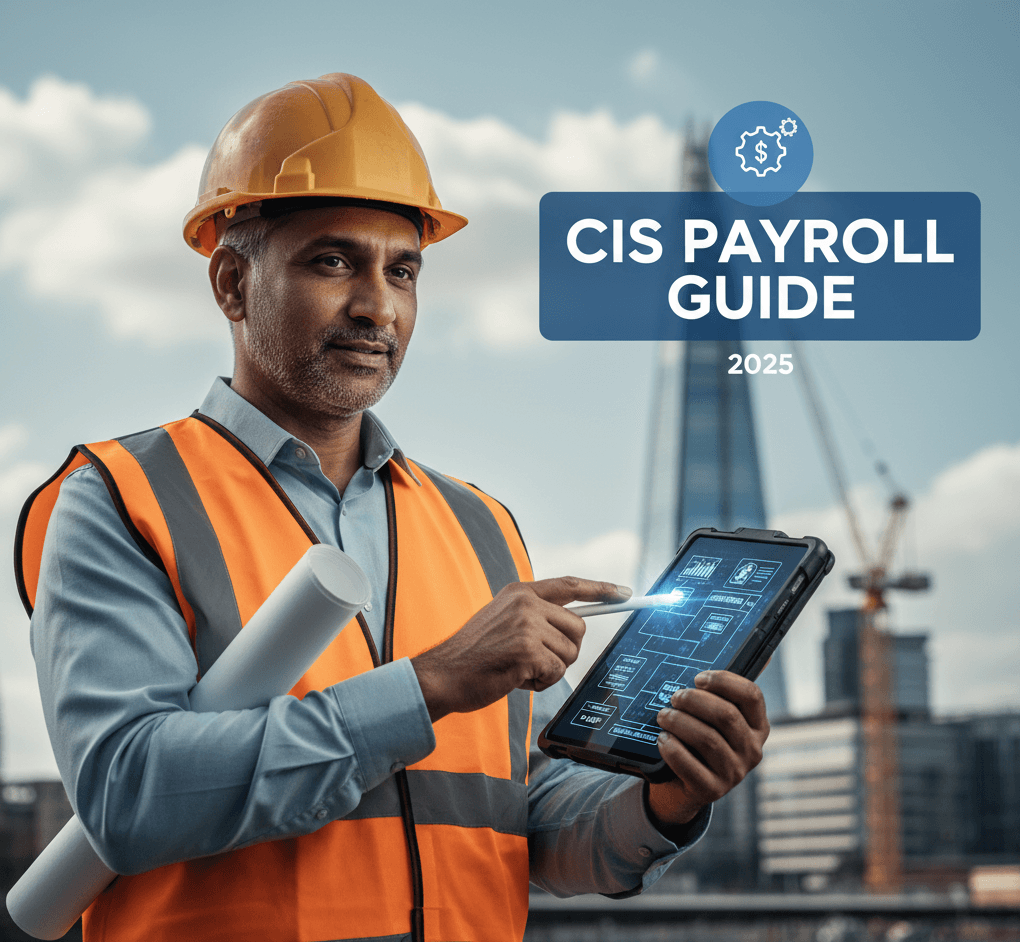“In 2025, the UK construction sector is projected to grow by 18% over the next five years, yet non-compliance with CIS payroll rules could cost businesses up to £3,000 in fines per infraction. Do not let administrative oversights derail your project timelines.”
Key Areas We Will Cover
- Compliance Basics: Essential steps to register and stay aligned with HMRC requirements.
- Defining CIS Payroll: What it means for contractors and subcontractors in the construction industry.
- Scope of Work Covered: Examples of qualifying construction operations and key exceptions.
- Registration and Verification Processes: How to get started and maintain subcontractor status.
- Monthly Returns and Payments: Timelines, deductions, and best practices for submissions.
- 2025 Updates and Changes: Critical adjustments, including the new £3 million threshold and traffic management inclusions.
- Tailored Solutions for Compliance: How specialist services can simplify your CIS obligations.
Introduction
Navigating CIS payroll in 2025 is crucial for UK contractors, as the Construction Industry Scheme ensures timely tax collection while supporting the sector’s projected 18% growth through to 2030. This comprehensive guide demystifies CIS payroll, from its core principles to the latest HMRC updates, empowering you to avoid penalties and streamline operations. Whether you are a main contractor managing subcontractors or a business on the cusp of the new £3 million threshold, understanding these rules will safeguard your finances and compliance. For tailored CIS-compliant payroll solutions built specifically for construction, explore FutureLink Group’s expert services.
Compliance Basics
Before diving into the intricacies of CIS payroll, it is vital to grasp the foundational compliance requirements set by HM Revenue and Customs (HMRC). The Construction Industry Scheme mandates that contractors deduct tax at source from subcontractor payments, treating these as advance contributions towards income tax and National Insurance. Failure to comply can result in penalties ranging from £100 for late monthly returns to £3,000 for persistent errors, underscoring the need for robust processes.
To begin, all contractors must register with HMRC before engaging subcontractors. This can be done online via the GOV.UK portal, converting your existing PAYE scheme into a combined PAYE/CIS setup if applicable. Subcontractors, meanwhile, should register to receive a Unique Taxpayer Reference (UTR) number, reducing deductions from 30% (unregistered rate) to 20% (registered rate). Maintaining accurate records of payments, materials costs, and verifications is non-negotiable, as HMRC may inspect these at any time.
For construction firms, integrating automated tools or specialist providers can mitigate risks. At FutureLink Group, our CIS contractor solutions handle verification, deductions, and submissions seamlessly, ensuring you meet HMRC standards without the administrative burden. This approach not only fosters compliance but also supports scalability as your projects expand.
Defining CIS Payroll
CIS payroll refers to the HMRC-administered framework under the Construction Industry Scheme, designed to curb tax evasion by requiring contractors to withhold tax from payments to subcontractors for qualifying construction work. Introduced to streamline tax collection in a historically cash-heavy sector, it applies primarily to self-employed subcontractors, who receive net payments after deductions; these count as prepayments against their annual tax liability.
For contractors, this means acting as a withholding agent: you verify subcontractor status via HMRC’s online system, calculate deductions (excluding material costs), and remit them alongside your PAYE obligations. Subcontractors benefit from simplified tax handling but must still file Self Assessment returns to reconcile over- or under-payments. Unlike standard PAYE for employees, CIS payroll treats workers as self-employed, offering flexibility but demanding vigilant classification to avoid IR35 pitfalls.
In essence, CIS payroll bridges efficiency and accountability, ensuring the £120 billion UK construction industry contributes fairly to public coffers while minimising end-of-year surprises for all parties.
Who It Applies To: Contractors and Subcontractors
Contractors under CIS include not just traditional builders but any entity spending over £3 million annually on construction (a key 2025 threshold, more on this later), such as property developers or public bodies commissioning works. Subcontractors encompass sole traders, partnerships, or limited companies providing labour or services.
Even non-construction businesses qualify as “deemed contractors” if they regularly outsource building projects, expanding the scheme’s reach. Foreign entities working in UK waters must also comply, registering via HMRC’s international channels.
Scope of Work Covered
The scheme encompasses a broad array of “construction operations” carried out in the UK or territorial waters, focusing on labour-intensive tasks that shape the built environment. Qualifying works include:
- Site preparation, such as excavation, demolition, and groundwork.
- Construction of structures like buildings, bridges, and civil engineering projects.
- Installations of systems for heating, ventilation, air conditioning, electrical wiring, and plumbing.
- Painting, decorating, and external cleaning of permanent structures.
- Alterations, repairs, and maintenance of existing buildings.
These activities must relate to permanent or temporary structures on land, ensuring comprehensive coverage for the sector’s diverse needs. However, the scheme excludes certain peripheral tasks to avoid overreach.
Key Exceptions
Not all site-related work falls under CIS payroll. Exceptions include:
- Surveying and Architectural Services: Purely advisory roles, like land surveying or design without on-site labour, are exempt.
- Non-Construction Site Activities: Operating canteens, providing security, or supplying materials without installation (e.g., mere delivery of bricks).
- Tenant-Specific Works: Alterations primarily for a leaseholder’s benefit, unless integral to the structure.
- Off-Site Fabrication: Manufacturing components away from the site, provided no on-site assembly occurs.
Consult HMRC’s CIS340 guide for nuanced interpretations, as misclassification can trigger audits. For construction-specific clarity, FutureLink Group’s solutions integrate these distinctions to prevent costly errors.
Registration and Verification Processes
Registration is the gateway to CIS payroll compliance. Contractors must sign up via GOV.UK before their first subcontractor payment, providing business details and receiving a CIS marker on their PAYE scheme. Subcontractors register similarly, submitting UTR applications to secure lower deduction rates. Processing typically takes days, but an unverified status defaults to 30% withholding.
Verification is an ongoing duty: contractors must check subcontractor details (name, UTR, National Insurance number) against HMRC’s database before each payment, valid for 12 months thereafter. Online tools facilitate this, but errors can lead to higher deductions or penalties.
Streamlining these steps is straightforward with expert support. FutureLink Group offers rapid onboarding, guiding UTR applications and automating verifications to keep your payroll friction-free.
Monthly Returns and Payments
Contractors must submit monthly CIS returns by the 19th of the following month, detailing all subcontractor payments, deductions, and material exclusions, even if no payments occurred. Late filings incur £100 fines (escalating to £200 after two months), while underpayments attract interest.
Deductions of 20% for registered, 30% for unregistered, are paid quarterly or monthly alongside PAYE, with records retained for three years. Subcontractors receive payment statements promptly, aiding their Self Assessment.
To enhance accuracy, adopt cloud-based payroll software or outsourced services that automate calculations and submissions, reducing error rates by up to 90%.
2025 Updates and Changes
The 2025 landscape for CIS payroll introduces targeted enhancements to broaden applicability and bolster enforcement. Key shifts include:
- £3 Million Threshold Expansion: From April 2025, businesses exceeding £3 million in annual construction spend become “deemed contractors,” regardless of core operations, lowering the prior £1 million over three years bar to capture larger non-specialists.
- Traffic Management Inclusion: Effective March 2025, specific traffic control services on construction sites (e.g., signage and barriers) qualify as operations, widening subcontractor obligations.
- Gross Payment Status Reforms: Stricter tests from April 2024 carry over, emphasising compliance history to prevent abuse, with digital verification enhancements for faster processing.
- Reporting Streamlining: Increased integration with Real Time Information (RTI) systems for seamless HMRC data flow, minimising manual inputs.
These updates aim to align CIS with the sector’s growth, projected at 0.5% for new work output in 2025. Stay proactive: review your spend against the new threshold and update contracts accordingly.
Conclusion
Mastering CIS payroll in 2025 equips UK contractors to thrive amid regulatory evolution and industry expansion. From defining deductions and scopes to embracing updates like the £3 million threshold, compliance is not merely obligatory; it is a strategic advantage that averts fines and fosters trust. By prioritising registration, accurate returns, and tailored tools, you can focus on delivering exceptional projects. Remember, the right partner amplifies your efforts: discover how FutureLink Group’s CIS solutions can transform your payroll into a seamless asset.
Frequently Asked Questions About CIS Payroll
Navigating CIS payroll raises common queries, especially with 2025’s updates reshaping thresholds and inclusions. This section addresses the essentials, drawing on HMRC guidelines to clarify misconceptions and guide your next steps.
CIS payroll applies to self-employed subcontractors in construction, with contractors deducting 20-30% tax at source as advance payments, excluding materials. PAYE, for employees, deducts income tax and NI via regular payroll runs, without the same verification steps.
The £3 million annual spend threshold from April classifies more firms as deemed contractors, while March’s traffic management inclusion expands covered works. Review your expenditures to register if needed.
Fines start at £100 for returns up to one month late, rising to £200 for two months, and £3,000 for deliberate errors or persistent non-compliance.
Yes, via Self Assessment; over-deducted amounts are refunded post-filing, typically within weeks, provided accurate records are kept.
Our solutions automate verifications, deductions, and returns, with same-day payments and insurance included from just £10 weekly, ideal for scaling construction teams.

Craig Moss
Craig Moss is a seasoned professional in the employment and recruitment industries, based in Kings Langley, UK. With over 30 years of experience, including a successful tenure as a central London realtor handling properties up to £3 million, he now leads an exciting management role at Futurelink Group. Specialising in compliant payroll solutions for contract recruitment, Craig helps clients increase margins by up to 30% while navigating complex legislation. His people-focused approach, honed through decades in sales and people management, ensures both recruiters and workers benefit from tax-efficient, compliant solutions. Passionate about building strong relationships, Craig thrives on delivering results that drive business success.
Secure Seamless CIS Payroll Today
Ready to eliminate compliance headaches and accelerate payments? Contact FutureLink Group for a free consultation on our CIS-compliant solutions tailored for construction, with same-day payouts and full HMRC alignment. Get started now and build with confidence.



